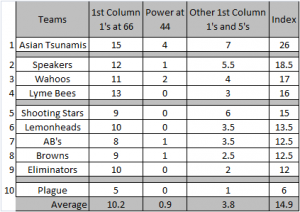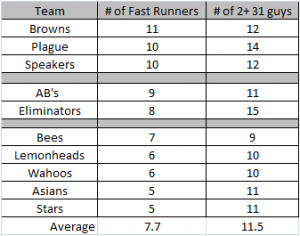Fielding
Arrogant Bastards vs. Eliminators
“Baseball is like church. Many attend, few understand.”
― Leo Durocher
Game 1
Hamels squares off against Volquez…neither would factor in the decision. The AB’s muster 2 solo HR’s (still trending…) from AGone while Cutch drives in Pollock and Correa drives in Cutch 2 innings later. This one would go….wait for it….EXTRA INNINGS!!!! Back-to-back doubles in the bottom of the 12th by Adam Jones and Ethier give the Eliminators a 3-2 walk-off victory. Wilson picks up the win while Brach suffers the loss. The Elim’s leave 13 on as they just set the tone for the start of a crazy series. The AB’s only muster 5 hits but extend the Solo HR streak to 9.
Game 2
Scherzer faces Ventura…hold on tight boys; this one is gonna be a bumpy ride. Trout grounds to 2nd to start the game and the AB’s then go BB, BB, BB, single, BB, single, runner picked off 1st w/ bases loaded, single, single, and Trout ends the 5 run 1st w/ a grounder back to the box. I mean you see that kind of inning every game, right? In the top of the 2nd Parra leads off and reaches on a Correa error, AGone doubles, Stanton BB’s and then Ortiz hits into an RP (well it is the most bizarre play in my brain) DP on a grounder to 3rd – Donaldson steps on 3rd and throws to first and the AB’s get a 6th run to push the lead to 6-0. Stop and think about that DP for a second…ok, moving on. A Correa 2-run 3rd inning HR caps a 3-run inning for the Elims to trim the lead to 6-3. In the 4th the Elims go single, single, single, single, fly out, 3-run HR to take an 8-6 lead. Stays that way until the top of the ? when with 2 outs Parra hits…wait for it…the AB’s 10th solo HR to start the season to cut the lead to 8-7. Still with 2 outs AGone BB’s as Giancarlo Stanton steps up and says…enough is a enough…and he belts a 2 run HR (NON SOLO…TIME TO PARTY IN THE STREETS…WHERE IS NEAL COTTS?) to put the AB’s up 9-8. But in the bottom of the 8th, a 2-out double by Donaldson rips Wade Davis’ heart right from his chest as Cutch walks home to tie it at 9-9. Guess what?…we go EXTRA INNINGS!!!! Forsythe leads off the 10th w/ a single and steals 2nd on a failed H&R attempt. Andrus SAC’s him to 3rd and Mike Trout delivers with a single (HIS ONLY HIT OF THE SERIES!!!!!!!!!!!!!!!!!!!!!!!!!!!!!!!!!!!!). 2 batters later Trout would score on an AGone RBI double. In the bottom of the 10th the Elims go single, BB, BB to load the bases with no one out. Donaldson hits a SAC fly plating Pollock and with 2 outs and runners on 2nd and 3rd Heyward rolls an error number to the SS…now Addison Russell had to the enter the game to play 2nd base due to some other moves earlier, so Elvis Andrus was at SS as an 8. Elvis fielded one and threw out Heyward to save the game. (It was the 2nd time in the game that Elvis fielded one on an error play). GEE WHIZ…the AB’s win in 10, E-O-LEVEN to TEN. Winner is Jansen with a save for Dyson as Gott gets the loss.
Game 3
As if the first 3-plus hours of action weren’t enough the scene shifted to the AB’s turf as Miller took on Lester. The AB’s took a 1-0 lead in the 2nd on a 2-out RBI single by Elvis Andrus. Shelby Miller retired the first 10 batters he faced; and then, he went to church (see the quote…again). The next 8 Elims go double, BB, fly out (YEAH WE GOT 2 OUTS!!!!), double, single, BB, BB, double clears the bases, double scores the guy that cleared them, and a fly out to end the inning!!! TOUCHDOWN Eliminators!!!!! 7-1 Eliminators. Jones drives in 2, Ethier 1, Castillo 3 and Pollock 1. In the bottom of the 4th, Forsythe gets a 2-out double to plate Gardner and then Stanton comes up to jack a 3-run HR to cut the lead to 7-5. Both starting pitchers are downgraded. . .just like in GAME 2. In the 6th, Stanton drives in another run with a 2-out single to make it 7-6; and in the 7th Russell Martin hits a solo HR to TIE it up AGAIN in the series 7-7. GUESS WHAT? WE GO EXTRA INNINGS!!!!! Quick note – Shelby Miller actually settled in to go a much needed 8 innings for the AB’s as EVERY relief pitcher for the AB’s was on the clock…FOR THE 2ND STRAIGHT GAME!
Adam Jones led off the 11th with a solo HR, Martin dropped a foul pop (in 11 games he caught a 14, 12, and now an 11 inning game); and with 2 outs Forsythe made an error, Heyward pinch ran, stole and scored on yet another 2 out hit by Castillo…nothing mustered from the AB’s in the bottom of the 11th and the Elims hold on for a 9-7 win. O’Day gets the W while Jansen takes the L.
Game 4
As Speakers manager Brian ‘BDUB’ Williams looked on – in attendance for a beer and some advanced scouting – two former Speakers squared off in game 4 as Salazar and Felix ‘The King’ Hernandez feared taking the bump. Fear? Who wants to pitch on this night? Parra leads off (Trout dropped from that spot) with a double and, after a fly out, AGone coaxes a 1-out BB. Up steps Mike Trout who–even though he is scuffling–legs out a fielders choice to keep the inning alive. Up steps Big Papi who deposits The King’s next pitch into Clyde’s poop-filled yard (Bill has moved out…management needs to poop scoop) for a 3-0 AB’s lead. The AB’s would tack on 3 more in the 3rd on 3 BB’s, a SAC fly RBI by Ortiz and 2-out 2-run double by Swihart. AGone would plate Addy Russell in the 4th for a 7-0 lead. The Elims would not go quietly as Freddie Freeman jacks a 2-run shot in the 5th and Pollock double home 2 runs in the 7th to cut the lead to 7-4. Kevin Pillar would hit a 2-out solo HR in the 8th to give the AB’s an 8-4 cushion and a series split. Salazar picks up the win as The King suffers the loss.
Series Notes – series took nearly 5.5 hours to play.
AB’s went 11 for 34 w/ RISP hitting .324 while the Elims went 14 for 50 (YES FIFTY) for a .280 clip.
AB’s hit .229 overall in the series but out-homered the Elims 8-5.
AB’s used 16.2 innings of RP as the Elims used 15.2.
Elims out-hit the AB’s 44-35…but it was a roll fest…I’m still spent the next evening.
AB Quick Notes
7-5 after 3 very different series.
35 innings of bullpen used mostly due to 6 of the 12 games going extra frames (about 12% of overall BP used as 13% of the season is completed).
AB’s played 8 consecutive 1 run games from games 3-10 going 5-3 in those contests.
Mike Trout is hitting .104 but is tied with Parra for most runs scored at 8.
Quite possibly the strangest start to one of my seasons since I’ve seen in this league.
Power and OBP
1) 1st Column 1’s at 66
2) Power numbers at 44
3) Other 1st Column 1’s and 5’s. (1’s are given 1 point and, since 5’s are not always HR’s, they count as .5 points)
1) Players with MLB OBP +.345
2) Players with MLB OBP +.375
Cheater Cards, Speed and Moving Runners
• Two teams, the Lemonheads and Eliminators did not draft any cheater cards.
• The Lyme Bees lead the way and filled out their bullpen with 4 RP cheater cards.
• The Tsunamis added three including 1 RP Hinojosa and two late position players Gutierrez and Rayburn to protect themselves against lefty starting pitchers. The Speakers surprising drafted three cheater cards but all three of them come with the asterisk. Severino is a top prospect though his value as a 4th game starter in the playoffs is undeniable. Hernandez also has to be considered a cheater card since it is one of the most valuable cards in the entire deck and Hernandez himself does not provide as much value in MLB. The asterisk has to be placed on Hernandez as he is a young player with upside who was a huge part of the 2015 Dodgers and started in the playoffs. Also being asterisked would be Joe Blanton. While the Speakers do not need his starts for the playoffs and his 13 grade relief appearances are not cheater-like, his two starts with a grade 13 RHSP/+42 control rating are definitely cheater starts. The Stars drafted 3 cheaters as well with two G4 playoff starters (again they are not cheaters as relievers but their playoff starts are cheaters) and Casali.
• The Wahoos chimed in with two: Colabello (an asterisk we discussed above) and Blanco.
• Three teams came in with one cheater starter all being game 4 playoff assets.


